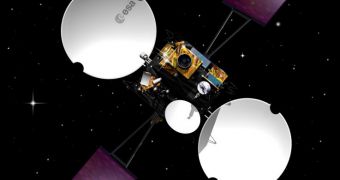The Advanced Relay and Technology Mission (Artemis) spacecraft was a massive revolution in telecommunications technologies for the European Space Agency (ESA), when it first launched. Now, a full decade later, experts look back at one of the most impressive European space assets.
Some of the most innovative – at the time – technologies that Artemis carries include laser links for communicating with relay stations on Earth, as well as using ion thrusters for orbital maneuvers.
The spacecraft launched back on July 12, 2001, and the mission was nearly lost even before it got the chance to get off the ground properly. The geostationary Earth orbit satellite (GEOS) was injected into a low transfer orbit, which severely jeopardized its chances of success.
In fact, many believed that the mission was already lost. But mission managers did not give up, and began an 18-month process of boosting the spacecraft to its proper geostationary orbit. Combining extreme dedication with advanced algorithms and computer hacks, they managed to do this.
As a reward for the massive volumes of work and patients that went into accomplishing this objective, the satellite is still in operation today, even if some of its electronics equipment were affected by the launch error.
In the time it spent in orbit thus far, the spacecraft managed to produce the first laser data link between satellites that were flying in different orbits around the planet. Another innovation was the ability to withstand the large number of reprogramming sequences its mission controllers put it through.
Artemis was also the first satellite to reach geostationary orbit using ion propulsion exclusively. As it was heading to its destination, it endured the longest drift of any spacecraft ever (18 months).
“Artemis has delivered tremendous service availability over its entire operational life at full satisfaction of final users. The capability and professionalism of the teams in Fucino and Redu are the basis of the Artemis achievements,” says Daniele Galardini.
She holds an appointment as the head of ESA Redu Center, and manages the Artemis mission for the space agency. The Redu station in Belgium houses the Artemis mission control center and a Ka-band ground terminal with a 13.5-meter dish antenna.
Artemis also provides in-orbit data-relay services for ESA's Automated Transfer Vehicles (ATV) en-route to the International Space Station (ISS). Its main instruments are SILEX (Semiconductor-laser Intersatellite Link Experiment), SKDR (S/Ka band Data Relay) and LLM (L-band Land Mobile).

 14 DAY TRIAL //
14 DAY TRIAL //